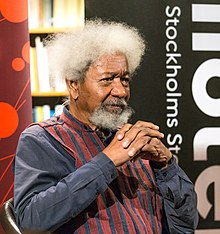Welcome to my blog,
This blog is part of our study. This Thinking activity is based on "A Dance of the Forest" by Wole Soyinka and was assigned by Megha ma’am Department of English MKBU.
Wole Soyinka
Wole Soyinka is a prominent Nigerian playwright, poet, essayist, critic, and Nobel laureate in Literature. Born on July 13, 1934, in Abeokuta, Nigeria, Soyinka is renowned for his significant contributions to African literature and his engagement with political and social issues.
Soyinka's literary career began to flourish in the 1950s and 1960s. He gained international acclaim for his plays, poetry, and essays that often address themes such as power, tyranny, and the complexities of post-colonial African societies. One of his groundbreaking works is the play "A Dance of the Forests," which premiered in 1960 during Nigeria's independence celebrations. This play marked the beginning of Soyinka's exploration of Nigerian identity and the challenges facing the newly independent nation. In 1986, Wole Soyinka received the Nobel Prize in Literature, becoming the first African laureate. The Nobel Committee recognized his "wide cultural perspective and poetic overtones" in his works, celebrating his ability to merge traditional African theater with Western literary forms.
Apart from his literary achievements, Soyinka has been an outspoken advocate for human rights, democracy, and social justice. He has faced political persecution and imprisonment in his home country due to his activism against oppressive regimes. Throughout his life, Wole Soyinka has demonstrated a commitment to artistic expression, intellectual rigor, and the pursuit of justice, leaving an indelible mark on the global literary landscape.
A Dance of the Forests

"A Dance of the Forests" is a seminal play written by Wole Soyinka, the renowned Nigerian playwright and Nobel laureate. The play premiered in 1960, coinciding with Nigeria's independence celebrations, and was later published in 1963. It stands as one of Soyinka's most significant works, delving into the complexities of post-colonial Nigeria and addressing critical socio-political themes.
The play begins with a Dead Man and a Dead Woman emerging from their burial in a forest, seeking justice for their past lives as a captain and his wife, tortured and killed by Emperor Mata Kharibu and Madame Tortoise. Aroni, a god, sends four characters - Rola, Adenebi, Agboreko, and Demoke - to the Gathering of the Tribes to gain knowledge about their past lives and atone for their sins. Obaneji, disguised as a human, invites them to a welcome dance for the Dead Man and Woman. Eshuoro, seeking vengeance, accuses Demoke of causing his death during a tree carving incident.
The narrative shifts back in time to Mata Kharibu's court, revealing the soldier's refusal to go to war, resulting in castration and enslavement. The court counselors, including Rola, Adenebi, Agboreko, and Demoke, do not intervene, leading to the soldier's tragic fate. The scene ends with the soldier's pregnant wife, leaving her fate ambiguous.
Human intervention with a petrol truck smothers the forest, prompting the Forest Head to fight against soul-deadening habits. In a climactic moment, Eshuoro sets fire to the totem Demoke climbs, causing a fall. The play concludes with mortal characters discussing their newfound knowledge and the Forest Head acknowledging his solitary struggle against encrusted habits. The complex narrative weaves together themes of justice, betrayal, and the cyclical nature of history. The play is a symbolic and allegorical exploration of Nigerian identity, reflecting the hopes and challenges of the newly independent nation. Through a theatrical dance of characters, themes, and symbols, Soyinka critiques romanticized notions of the past, exposing the flaws and contradictions of the present. The forest, in particular, becomes a central metaphor representing the collective consciousness of the Nigerian people, entangled in a dance that reflects the struggles, aspirations, and uncertainties of the nation's journey.
"A Dance of the Forests" is celebrated for its innovative use of traditional African theatrical elements and its profound engagement with the socio-political context of its time. The play showcases Soyinka's mastery in blending Yoruba mythology, cultural symbolism, and contemporary issues, creating a rich and thought-provoking narrative that continues to resonate in the exploration of African identity and post-colonial challenges. The narrative climaxes with the forests being smoked out, symbolizing human interference, and the Forest Head's solitary determination to confront soul-deadening habits. Demoke, manipulated by Eshuoro, ascends a totem set ablaze, leading to his fall and subsequent discussion with his father and other mortals about their revelations. The play masterfully weaves timelines, characters, and symbolic elements to explore profound themes of justice, history's cyclical nature, and the artist's social role.
1. Write a proposed alternative end of the play 'A Dance of the Forest' by Wole Soyinka.
The proposed alternative end of "A Dance of the Forest" by Wole Soyinka takes a positive turn, focusing on redemption, unity, and a fresh start for the community. After Demoke returns the Half-Child to the Dead Woman, bringing release to the Dead Man's spirit, the atmosphere shifts. Eshuoro's triumphant yell and departure with his triplets mark a symbolic departure of chaos. The approval of Forest Head adds an element of communal acknowledgment.
As dawn breaks over the forest clearing, Demoke reflects on the transformative events of the night. Rola, having endured the trials together, tentatively approaches Demoke. In a moment of reconciliation, Demoke acknowledges the shared ordeal, accepting Rola's extended hand. The scene symbolizes a new beginning for the characters, emphasizing unity and resilience.
With the villagers waking up and emerging into the clearing, the Old Man, a voice of wisdom, commends Demoke for his courage. The village begins to stir with renewed energy and purpose. Agboreko, recognizing the significance of the sacrifice, calls for a collective effort to move forward with purpose and unity.
The backdrop of daily tasks and the rhythmic activities of the villagers create a sense of community and optimism. The alternative end depicts a communal spirit and a shared commitment to rebuilding. As the sun rises higher, Demoke and Rola, now reconciled, symbolize a couple ready to lead the community into a brighter future. The lights fade as they venture into the forest, signaling a hopeful and harmonious conclusion to the play.
2. Write a note on the play 'A Dance of the Forest' by Wole Soyinka.
"A Dance of the Forests" by Wole Soyinka is a complex and multifaceted play that delves into key issues such as decolonization, tradition and history, the role of the artist in society, and the interplay of Western influences in an African context. Soyinka explores the challenges faced by a newly independent Nigeria, using characters like Demoke to symbolize the need to confront the past for a fresh start. The play incorporates Yoruba rituals and traditions to reflect on the connection between past and present, utilizing the Dead Man and Woman as symbols of forgotten heroes rejected by the evolving society.
The structure of the play is intricate, with a non-linear progression that includes flashbacks to the court of Mata Kharibu and various choruses, creating a rich and layered narrative. Soyinka skillfully blends reality, surreal elements, rituals, and straightforward storytelling, creating a theatrical experience that challenges conventional Western dramatic conventions. Language plays a crucial role in the play, with characters using distinct speech styles reflecting their personalities and roles in the narrative. From Agboreko's reliance on proverbs to Rola's coquettish yet vulgar expressions, each character contributes to the richness of the linguistic tapestry.
Soyinka's work is influenced by both African and Western literary traditions, with echoes of Greek tragedies and Shakespearean elements. However, he diverges by rejecting a Christian worldview and emphasizing the artist's role in challenging the audience's complacency. The play also serves as a commentary on postcolonial Africa, aligning with Frantz Fanon's ideas on decolonization. Soyinka exemplifies the resilience of African artistic expression despite the challenges of colonialism. The characters, especially Demoke, undergo a transformation from prioritizing individual concerns to embracing communal responsibility, echoing Fanon's emphasis on community.
The political implications of using English as the medium of expression are discussed, with Soyinka aiming to expose a wider audience to Yoruba culture. However, this choice raises debates about cultural authenticity and accessibility, echoing discussions within postcolonial literature. Soyinka's artistic approach, labeled as "nativism" by some, is explored in the context of his prioritization of timeless themes over historical specifics. While Soyinka draws on real historical events in his plays, critics argue that he leans toward broader messages.
The play is not without its criticisms, with some pointing out moments of obscurity and unevenness in its execution. However, Soyinka's commitment to social justice through art, his avoidance of sentimentality, and his courage in addressing harsh realities make "A Dance of the Forests" a powerful and commendable work that challenges audiences to think critically and respond intuitively.
Conclusion
In conclusion, Soyinka's "A Dance of the Forests" is a testament to the playwright's artistic prowess and his commitment to challenging conventional norms. Through its unconventional structure, archetypal characters, and multi-dimensional sensory engagement, the play becomes a dynamic exploration of timeless themes. It transcends the boundaries of Western dramatic traditions, offering a rich and thought-provoking experience that lingers in the minds of those who witness its performance.
Word Count - 1507
Thank You for Reading and Visiting...






No comments:
Post a Comment